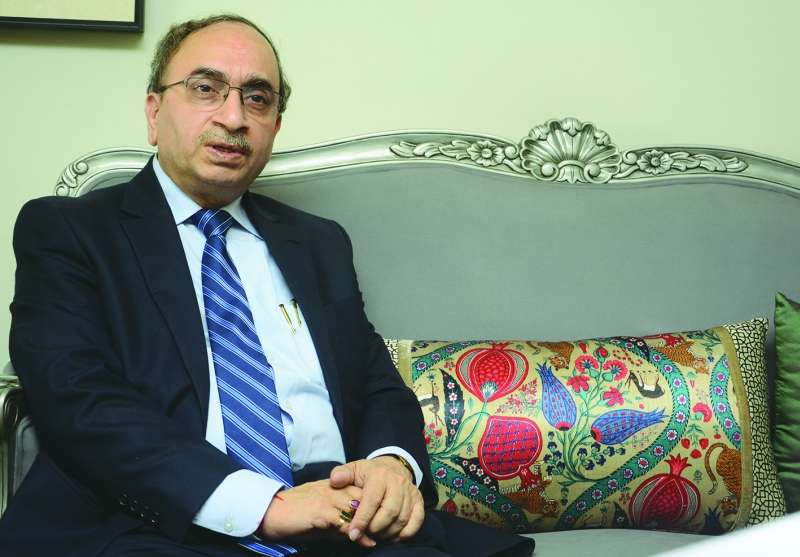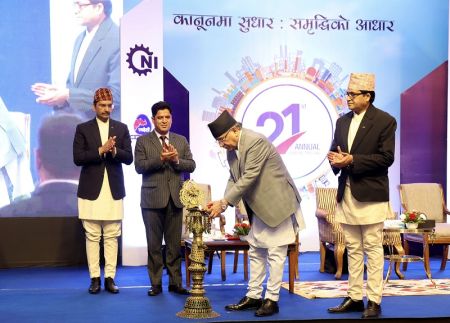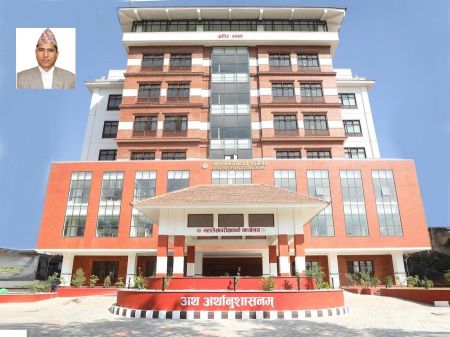Ever since its establishment in 1992 as the first Nepal-India banking joint venture, Nepal SBI Bank has remained a major commercial bank in Nepal backed by strong financials, efficient delivery of services, technological adaptations/innovations and skilled human resources. Currently, the bank is operating 95 branches across the country, out of which 23 are located in the Kathmandu valley. Nepal SBI is among the 190 foreign subsidiaries of the State Bank of India (SBI), the largest commercial bank in India.
Dinesh Khara, managing director of Global Banking and Subsidiaries at SBI, was in Kathmandu as part of his regular official visit and also to participate in a banking programme, as a panellist, organised by the Nepal Banking Institute on February 17. Khara is a renowned Indian banker who joined SBI as a probationary officer in 1984, and has amassed vast experience in all areas of commercial banking including SME/corporate credit, retail credit, branch management, fund management, deposit mobilisation and international banking operations. In an interview with Sanjeev Sharma of New Business Age, Khara talked about SBI’s global banking presence, the 2017 merger of five affiliate banks into SBI, performance of Nepal SBI Bank, issues in the Nepali banking sector, among other matters. Excerpts:
As the head of the Global Banking and Subsidiaries division of SBI, how do you assess the bank’s current global position?
SBI’s global banking contributes 10 percent to the bank’s total balance sheet size of USD 500 billion. In terms of non-performing assets (NPA), global baking’s NPA is less than 0.50 percent of the total book of the bank and profitability is as per our expectations. SBI’s international banking has grown this year by almost 20 percent.
How satisfied are you with Nepal SBI Bank’s performance?
Nepal SBI Bank is also doing exceedingly well. We are very proud of its return on assets (ROA), return on investment (ROI) and return on equity (ROE). It is also a matter of pride for us in terms of the growth of Nepal SBI Bank and the quality of assets which they have on their books. We actually look at Nepal SBI as being a very strong franchise in Nepal. We are trying to offer Nepal SBI with the best practices in banking that we have adopted at the State Bank of India both in terms of underwriting as well as technology. The State Bank of India has also embarked on a journey which will make the bank more tech savvy. We are actually looking forward to a similar kind of replication at Nepal SBI Bank. I would like to mention that 87 percent of SBI’s transactions in India are done outside of the branches through ATMs and digital banking channels.
The bank has been doing very well for the last 10 years. It is meeting the expectations of the State Bank of India. The best part in this regard is that Nepal SBI Bank has adapted itself to the local culture and has aligned very well with the expectations of the local population, the government of Nepal and the Nepal Rastra Bank. They have branched out into some of the unbanked areas of Nepal. While meeting those expectations, they have look out for the benefits of the best practices that we have been following at the State Bank of India. As one of the most important foreign subsidiaries, we have been supporting and nurturing Nepal SBI Bank and want it to become a major player in the Nepali banking sector.
What were the challenges and how were the obstacles removed?
Any new entity faces challenges during the initial phase. The management of Nepal SBI Bank has very comfortably surmounted those challenges and they are all behind them. So, that’s not something we at the State Bank of India were concerned about. But of course, we did do the hand-holding at that point in time to see that they came out of the issues.
You are credited for the 2017 mega merger between SBI and its five associate banks that placed SBI among the world’s top 50 banks. How did a merger of this scale happen?
Before the merger, we did a comprehensive gap analysis. We had a clear action plan in place to bridge the gap between the State Bank of India and its various associate banks. Having done that, we could take several decisions which helped us to prepare ourselves well in time before the effective date of the merger. In addition to the data merger, the integration of human resources is a very important and critical piece of any merger. As a service industry, it is very essential that this aspect should never be ignored. In this respect, we were always very mindful and engaged with all stakeholders including the staff of the banks so as to put to ease their anxieties regarding the merger.
This approach actually helped us going forward because the staff started contributing almost from day one when they came into the fold of the State Bank of India. We could have the trained pool of resources which helped the bank in further increasing its footprints and also in improving its business profile. Before the merger, the share of the State Bank of India was about 17 percent in deposits and 15 percent in loans and advances. Post-merger, our share in deposits has reached 23 percent and almost 20 percent in loans and advances. The merger has proved to be very useful for the bank because if it hadn’t happened, SBI would have been required to support the banks in terms of capital course. So, due to the merger we could ensure our position in terms of optimising capital, costs of operation and offer the best in class products and services to the customers of those associate banks which have significantly enhanced customer experience.
What imperatives do you think this merger has for the Indian banking sector?
After the merger, the State Bank of India has become one of the top 50 global banks in the Fortune 500 list of companies. This gives us a size which is in-line with the status of the Indian economy vis-à-vis the global economies. Going forward, this size will also help us in ensuring that our growth path remains strong.
How do you view the growth of the Nepali banking sector?
The Nepali banking sector appears to be quite fragmented. The largest bank holds about 6 percent of the share in the country’s banking sector. And the number of banks is also too large. Perhaps, I feel there maybe situations, where at a point in time, the banks might consider joining hands together, and some kind of amalgamation and merger of the banking entities could be seen.
The Nepal banking sector has gone through a consolidation phase over the last 7-8 years. How successful do you think the central bank’s plan has been in terms of making BFIs financially stronger?
I think this as a very positive development, eventually leading to the healthy growth of the Nepali banking sector. Being the regulator, Nepal Rastra Bank has a very good overview of the banking sector and it can really suggest the course going forward. Also, they have adequate insight into the operation of various commercial banks. I think the central bank is the best judge in this context to encourage the mergers between the banking entities.
What do you think should be the appropriate policy for mergers?
In a democratic country, any policy which is thrust upon someone or something does not work well; it is something which should evolve. Going forward, the mergers might happen when bankers start to feel the need for more capital. Naturally, this is a process more guided by the board of directors of the banks. Once the management of banks realise that a merger is in their ultimate interest, I am sure they will contribute to the best of their abilities.
The recurring problem of shortage of investible funds has created several difficulties for banks in Nepal. What do you think is the long-term solution to this issue?
I think capitalisation of banks is a very important factor when it comes to meeting the credit needs of the economy. If at all banks are not in a position to raise capital, it clearly means investors are looking for better returns. Perhaps that is also an inflection point which will probably lead to the banks becoming financially stronger through the way of mergers.
How is Nepal SBI Bank tackling this problem?
Nepal SBI is a well capitalised bank and we have no challenges in this regard. We have decided that our capital can always be raised if the bank’s management requires it. The bank has adequate capital to support its present balance sheet size and also the normal business growth. As and when there would be a need, then Nepal SBI can always raise its capital through the issuance of rights shares because it is supported to the extent of 70 percent by the institutions investing in it- 55 percent by the State Bank of India and 15 percent by the Employees Provident Fund, Nepal. Considering the handsome returns the bank is offering I am sure the investors would be keen to continue with the subscription of the rights issue.
Banks in Nepal are too much dependent on deposit collection for funds. Whereas in India and other countries, debt instruments like debentures are widely used by banks. Do you see similar possibility of increasing debt instrument to increase resources in Nepal?
There are various ways. The government can raise funds through the debt instruments that are subscribed by banks. It is because the level of credibility of the government in any developing country is always at the maximum. The only thing is, there is a need for creating a market for debt-papers. As of now, the banks in Nepal are required to hold all such investments till maturity. If there are some components of such investments permitted for sale, there would be trading of the debt papers. The start of trading will lead to the creation of the market for such instruments. With the existence of the market, there will be more trading and the demand for such kinds of securities will grow. To support this, it might be a good idea in that maybe the federal government and NRB can think of having primary dealers, who are the depository of such securities. Doing this will actually enhance the market making capabilities of the economy.
Finally, would you like to add anything?
We are open to looking at the opportunities for growth wherever it exists in Nepal. Recently we opened five more branches at different locations of the country. We are more than happy to serve our customers and offer them quality services to meet their financial needs. Nepal SBI’s vision is to be the preferred bank for the economic transformation of Nepal and it is living up to the vision.





















